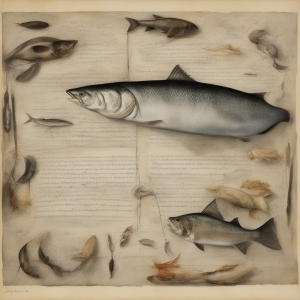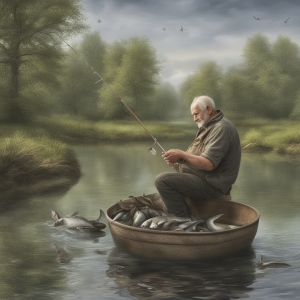Table of Contents:
In this modern age of fishing, there's more to the sport than just casting your line and bagging the biggest catch. One aspect that is becoming increasingly popular and important is catch and release. But what is it and why is it so significant? Read on to unravel the ins-and-outs of this practice.
Introduction to Catch and Release
Derived from the intrinsic love and respect for our aquatic life, catch and release is an angling practice where fish are caught and returned to their habitat immediately. This practice is not just a random act of kindness but a conscious effort to sustain fish populations and ensure they flourish for future generations.
Just as forestry involves practices that don't deplete our trees, catch and release is a response to the overfishing problem. It essentially involves the anglers enjoying the thrill of the catch, while also ensuring the survival of the fish. The ripple effect is a balance in our ecosystem, healthier water bodies, and a rewarding fishing experience.
Understanding the Ethical Debate
There's a significant debate surrounding catch and release fishing. For some, it's the perfect blend of enjoying the sport while also preserving the fish population. But others consider the practice unethical. They argue that it might cause unnecessary stress and pain to the fish.
Critics say that even if the fish are returned to the water, the trauma experienced during catching and handling might lead to their death. This viewpoint brings in a moral question: is it right to stress and potentially harm a living creature for a recreational activity?
On the other hand, supporters of catch and release highlight its benefits for the fish populations and ecosystems. According to them, it's a better alternative to removing the fish from the water permanently. They argue that with the right practices and tools, it's possible to minimise the harm done, ensuring the survival of the fish after it's released.
The Moral Debate of Fishing: Catch and Release
| Pros | Cons |
|---|---|
| Allows fishing for sport without depleting the fish population | Can cause stress and physical harm to fish |
| Provides a sense of accomplishment without ending a life | The survival rate after release can still be low |
| Most laws and regulations promote sustainable fishing | It's not always clear when it's morally okay to fish |
| Teaches patience and respect for nature | Could contribute to a shift in the ecosystem |
| Can promote tourism and local economies | May contribute to overall animal suffering |
Responsible Fishing: Why Ethics Matter

The big question is, why should we care about the ethics of fishing? Well, there are several reasons. Responsible fishing is about more than just sportsmanship, it's about being a steward of our planet. Fish are part of a complex ecological web. Any severe fluctuation in their population could create ripples across the food chain, affecting other marine and terrestrial creatures.
This practice is not just about individual species but the entire ecosystem. Conserving one species can cascade and benefit all marine life. A river enriched with a variety of fish species can provide a richer environment for birds, amphibians, and mammals, contributing to biodiversity.
Beyond the ecosystem, ethical fishing upholds human values. Catching fish only for the pleasure of sport and then releasing them is a great exercise in restraint and respect. It pays homage to the sporting spirit and acknowledges that the fish are more than just a trophy, they're a vital part of our world.
The Importance of Conservation in Fishing
Fishing plays a significant role in maintaining the diversity of our aquatic ecosystems. In numerous ways, the health of our waters and the well-being of aquatic residents are linked to our actions. This is where conservation comes in. Many fisheries around the world are threatened by human activities. Overfishing is a primary concern that can lead to a decline in fish populations, upsetting the balance in aquatic ecosystems.
By practicing catch and release, anglers contribute to conservation efforts, providing a chance for the fish to breed and maintain their populations. This ensures that future generations of anglers can enjoy the satisfaction of fishing, and the diversity of aquatic species can be preserved. Furthermore, releasing fish back into the wild can also help to balance the aquatic ecosystem, ensuring the survival of various other species reliant on fish for their survival.
Practical Tips for Ethical Catch and Release

So, how do we ensure that we're doing catch and release right? Here are some practical tips:
Firstly, use barbless hooks. These lessen the harm to the fish and make it easier to unhinge the hook upon release.
Secondly, handle the fish properly. If possible, don’t try to remove the fish out of the water. If you must, wet your hands first, as dry hands can take away the slippery, protective coating from the skin of the fish. Never handle a fish by the gills, as they are delicate and vital for the fish's survival.
Lastly, release the fish properly. Hold the fish gently under the water, facing it upstream to allow water to run through the gills, helping it regain strength before it swims away.
Remember, catch and release isn’t only about putting the fish back in the water. It's about exercising care and mindfulness throughout the process to maintain the fish's health and vitality.
Wrapping Up: The Moral Obligation of Every Angler
The practice of catch and release marries the thrill of fishing with the responsibility of preserving fish life. It helps us to treat the waters, not just as a source of recreation, but also a thriving ecosystem that we are accountable for. As anglers, our love for the sport should not overshadow the crucial role these water bodies play in maintaining biodiversity.
Moving forward, ethical fishing is the only way we can ensure sustainability. No matter the stance one takes in the debate about the practice of catch and release, it's clear that a balance must be struck. We can and must enjoy our hobby in such a way that it conserves rather than consumes our precious aquatic life.
Remember, each time you cast your line, you have a choice. Everyone can make a difference, one released fish at a time. It's more than just an act- it's a habit, an ethic, and a much-needed change. So the next time you catch a fish, think about what that really means and act accordingly. Because ultimately, being a responsible angler isn't just about how many fish you catch - it's about how many you let go.
Frequently Asked Questions: Moral Dimensions of Catch and Release Fishing

What is catch and release fishing?
Catch and release is a practice within recreational fishing intended as a technique of conservation. After capture, the fish are unhooked and returned back into the water before experiencing serious exhaustion or injury.
Why is catch and release considered more ethical?
Catch and release is deemed more ethical as it focuses on preserving the fish populations and minimizes potential negative impacts on the environment.
What are some criticisms of catch and release fishing?
Critics argue that catch and release can still cause significant stress to the fish, potentially leading to injuries or subsequent death after release.
How can one fish ethically?
On can fish ethically by adhering to local fishing guidelines, respecting size and catch limits, using gear that minimizes harm to fish, and practicing proper catch and release techniques.
Is catch and release always the best option for conservation?
Though it can benefit preservation efforts, catch and release may not always be the best option. Each fishing situation can be different, and it's important to use judgment and follow local regulations to best aid conservation.







